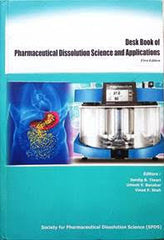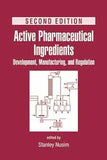Desk Book of Pharmaceutical Dissolution Science and Applications , Editors: Sandip Tiwari , Umesh V. Banakar, Vinod Shah
MUST HAVE - One of its Kind Book !
Desk Book of Pharmaceutical Dissolution Science and Applications , 1st Edition, Year 2015
Editors: Sandip Tiwari , Umesh V. Banakar, Vinod Shah
Publisher: Society for Pharmaceutical Dissolution Science (SPDS)
Deskbook of Pharmaceutical Dissolution Science and Applications , has been contributed and written by Expert Scientists across the Globe. The aim to provide the Academia, Industry and Research Scientists an overview of Basics and Fundamentals in the dissolution science and testing, recent developments in instrumentation and automation, changing regulatory requirements and innovations in the area of dissolution science and dissolution / in vitro release for novel dosage forms. The chapters provide details about the instrument operations, tip to overcome problems in desing and development with adequate literature citations. The chapters also reveal methods of statistical analysis and interpretation of dissolution test data; application of data in terms of correlation with bioavailability and bioequivalence. This is a unique book of its kind
Preface
The science of dissolution dates back to the late 19th century. While solubilization is the process by which a pure substance Solubilizes (dissolves) in a solvent, dissolution is defined as the process by which a solid substance enters into the solvent to
Yield a solution. Stated simply, dissolution is the process by which a solid substance dissolves. Over the year, dissolution science has progressed and has found a firm footing in drug development processes and various allied disciplines associated
within it, especially, in defining and establishing the quality attributes of pharmaceutical product and its performance, both in vitro and in vivo. Dissolution testing, of course, has emerged as regular quality control procedure in good manufacturing practices. Whether ornot its numbers have been correlated with biological effectiveness, the standard dissolution test is a simple and, perhaps, an inexpensive indicator of the physicochemical consistency of the product. Dissolution data is also useful in the early stages of drug development and formulation. In the early stages of development, the researchers take steps to optimize drug and dosage from characteristics that will influence subsequent data concerning biological availability. In this sense, the dissolution test can be employed prospectively while developing a formulation with appropriate drug release characteristics, and retrospectively to assess whether a dosage form is releasing the drug at the prescribed / predetermined rate and extent. The common principal assumption underlying these two uses of this test is that the dissolution test is able to adequate represent, if not predict, the biological performance, i.e., bioavailability, of the drug. As of date, in vitro dissolution tests seem to be the most reliable predictors of in vivo availability. Although official test have a great practical Value, the fact that there is steel a need for a test more directly related to bioavailability has been recognized. While the bioavailability of a drug Substance and drug products in humans can provide a confirmatory evidence of a potential relationship between dissolution and physiological Availability, it is often impractical to perform extensive and expensive human testing. As a result, the essentials of what is involved in developing And demonstration an in vitro – in vivo correlation is necessary. The intension of this deskbook is to present a comprehensive mass of critical information, as a ready reference, to R&D (formulation and Analytical), QC/QA and PK professionals concerning the science and application of effective dissolution testing and its utility in drug Development. Topics addressed include the scientific / Technical basis of role of dissolution testing in drug development, dissolution testing equipment with special emphasis on flow-through methods, in vitro – in vivo correlations and regulatory considerations.
TABLE OF CONTENTS :
Introduction
Preface
Foreword
Contributors
- Historical Highlights and the need for Dissolution Testing ( Vinod P. Shah, USA )
- Dissolution Science: Theories and Applications. ( Umesh Banakar , USA )
- Dissolution- Methodology and Scientific Principles. ( Suresh Venkataram, INDIA )
- Dissolution and Bioavailability: In-Vitro-In-Vivo Correlation (IVIVC), Bioavailability and Bioequivalence. ( Umesh Banakar , USA )
- In Vitro-In Vivo Correlation: Applications and Limitations. ( Jean-Michel Cardot, FRANCE )
- Comparison of Non clinical Permeability Techniques for BCS Classification- Tools to Augment Dissolution Outcomes. ( Vatsala Naageshwaram and Sid Bhoopathy, USA )
- Automation of Dissolution Testing. ( Samir Haddouchi , FRANCE )
- A Review of Dissolution Testing with Flow-through Cell (USP Apparatus 4) ( Jean Marie Glantzmann and Jean Louis Raton , SWITZERLAND )
- Compendial Requirements for Dissolution: A look at USP / EP / and JP Pharmacopoeias. ( Hakan Eroglu, Erem Bilensoy and A.Atilla Hincal, TURKEY )
- In Vitro Dissolution Testing of Nanoparticles Drug Delivery Systems. ( Mangal S. Nagarsenker, Vivek V. Dhawan and Sanket M. Shah , INDIA )
- Drug Release from Semisolid Dosage Forms. ( Flavian Stefan Radulescu and Dalia Simona Miron, ROMANIA )
- Comparative Analysis of Dissolution Data. ( Constantin Mircioiu, ROMANIA )
- Mathematical Treatment of Dissolution Data for Extraction of Vital Product Information. ( Mukesh C. Gohel , INDIA , Sandip B. Tiwari, USA and Jayyadan K. Patel , INDIA )
- Dissolution Testing of Generic Products : Regulatory Perspective. ( Raghunandan H.V. Harsha. J. and Mahesh B.K. , INDIA )
- Investigation of Out of Specification (OOS) Results Obtained in Dissolution Testing. ( Vijay U. Kshirsagar , INDIA )


















